The Palace of Holyroodhouse, also known as Holyrood Palace, stands at the opposite end of the Royal Mile to Edinburgh Castle.
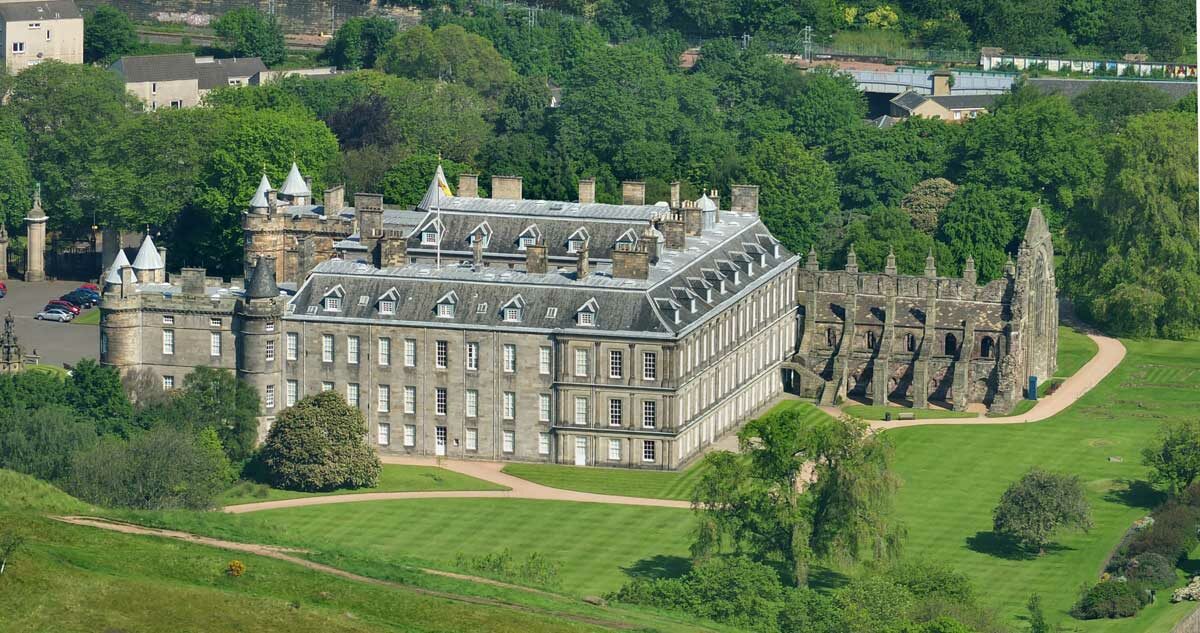
©A Meskins
Palace of Holyroodhouse: Royal Collection Trust
Today, the Royal Collection Trust (RCT), a registered charity, is responsible for managing some aspects of Britain’s royal residences including the Palace of Holyroodhouse.
The RCT tell us that the Holyrood’s grounds cover over 10 acres although most of that is given to the beautiful formal gardens.
The extensive garden, where the late Queen Elizabeth II hosted her much-loved garden parties has wonderful views over Holyrood Park and Arthur’s Seat.
In 2020, the Royal Collection director, Tim Knox opened a new physic garden outside the gates in the Abbey Strand, the last section of the Royal Mile.
It was Professors Sibbald and Balfour, founders of the Royal College of Physicians of Edinburgh who established the first physic garden at Holyrood in 1670.
For horticultural enthusiasts, that new garden has a remarkable historical trail, which if followed will take the researcher to the Royal Botanic Garden of Edinburgh.
How many rooms does the Palace of Holyroodhouse have?
The Trust say it has 289 rooms although that does include corridors and landings. However, only a small number are open to the public.
“Visitors can explore 14 magnificent historic and state apartments.”
Visit Scotland
What to see at the Palace of Holyroodhouse
- King’s Bedchamber
- Throne Room and Privy Chamber
- Mary Queen of Scots bedchamber, supper room and an outer chamber where the queen received visitors.
- The Great Gallery has over 100 portraits of Scotland’s kings and queens. Among them Macbeth, Robert the Bruce and of course Mary Queen of Scots. Perhaps the most intriguing is that of the mythical Fergus I (Fergus Mór).
- Great Gallery Ante-Chamber, once used by Bonnie Prince Charlie.
- Royal gardens
Queen’s Gallery
The Queen’s Gallery stands at the entrance to the Palace. It holds a regular programme of exhibitions from the royal collection.
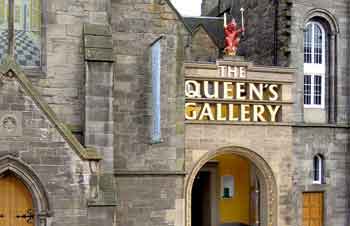
Built on the former site of the Holyrood Free Church and the Duchess of Gordon’s School, it provides exhibition space for the Royal Collection. It was opened by Queen Elizabeth in 2002.
The Royal Collection is one of the biggest art collections in the world and has in excess of one million objects which are regularly on display in both former and current royal houses across the United Kingdom.
For further information on booking tickets, admission times and help planning your visit to the Queen’s Gallery, go to the Royal Collection Trust website.
History of the Palace of Holyroodhouse
Although Edinburgh did not become the official capital city of Scotland until 1437, the story of Holyrood Palace began much earlier with the foundation of an abbey.
Holyrood Abbey
David I, the youngest son of King Malcolm III (Malcolm Canmore) and Queen Margaret (later Saint Margaret) founded an Augustinian abbey (Holyrood Abbey) in 1128.
With new monastic buildings, guest accommodation and royal chambers, the abbey expanded considerably over the next three decades.
By the early 15th century, Scotland’s monarchs favoured its more comfortable abbey over the bleak and inhospitable Edinburgh Castle.
As the parish church of the Canongate, it largely survived the destruction of the Protestant Reformation in 1560.
All that now remains of David’s original abbey are the ruins of the nave, the foundations of the choir, transepts and part of the chapter house. Ruins yes, but still a potent reminder of Scotland in another age.
James IV: from an abbey to a palace
It was James IV, at the time of his wedding to Henry VIIs daughter Margaret Tudor in 1503, who began the work of converting the abbey’s royal chambers into a palace. Under his guidance, a new tower, hall, chapel and gatehouse were built.
While the tower wall can still be seen today, the rest, other than a small part of the gatehouse, has, over the years, been swept away.
James V
Successive monarchs continued the development of Holyrood Palace. In 1528, James V built new royal lodgings housed in a large tower at the north west corner of the building.
The tower remains the oldest surviving part of the building.
It had a drawbridge and may also have had a protective moat which gave added protection to the royal residents.
Mary Queen of Scots
Perhaps more than any other of Scotland’s kings and queens with a connection to this historic building, Mary Queen of Scots is remembered best of all.
In 1544 and again in 1547, Henry VIII’s soldiers laid waste to the burgeoning grandeur of Holyroodhouse as they rampaged through the borderlands and Edinburgh.
It was England’s response to Scotland’s refusal to allow the marriage between the infant Mary Queen of Scots and Henry’s son Prince Edward.
To cement the bond between Scotland and France, Mary married the Dauphin of France in a ceremony in the Louvre, Paris in 1558. She was only 15.
However, Following the death of her husband, Mary returned to Scotland from France in August 1561 and made the royal apartments of Holyrood Palace her home.
Within days of her arrival, Protestant demonstrators, Antonia Fraser called them “reformers,” tried to force their way into her private chapel during a mass attended by her French uncles and servants.
It was an early sign of the tumult to come.
In 1566, pregnant with the future king (James VI and I), she witnessed the brutal murder of her Italian secretary David Rizzio.
Responsible for the killing was a group led by her husband, Henry Stuart, Lord Darnley.
Mary remained at the Palace of Holyroodhouse until 1567. However, by July of that year, she was a prisoner at Lochleven Castle and forced to abdicate in favour of her young son
Today the tower is the oldest part of the palace and houses Queen Mary’s chambers, rooms that the public can visit.
James made further improvements. But following the Union of the Crowns in 1603, the king and the royal household left Scotland for London.
Coronation of Charles I
After 1603, although it was used less, there was still a royal role for the building. In 1633, for example, it was the venue for the Scottish coronation of the deeply unpopular Charles I.
In 1649, Charles was executed and parliament abolished the monarchy, establishing in its place, a republic under the leadership of Oliver Cromwell.
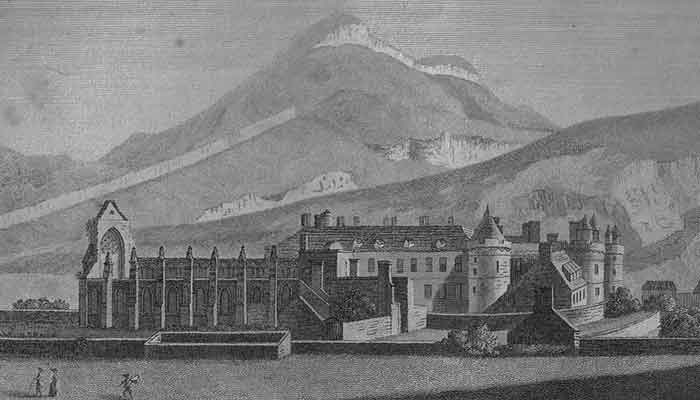
Oliver Cromwell
By the time Cromwell arrived in Edinburgh, after his victory over the Scots at the Battle of Dunbar in 1650, he was in no mood to leave the city with the building remaining intact.
Once again, the Palace of Holyroodhouse was sacked and left burning.
Following the period of Cromwellian rule, Charles II was restored to the throne in 1660 and the Palace of Holyroodhouse became a royal home once again.
Although Charles never lived at Holyrood, his brother James VII did spend some time there in 1679 and again two years later.
Jesuit College and Catholic printing press
In the process, James managed to infuriate the mainly Presbyterian local population by establishing a Jesuit college and Catholic printing press in the Palace.
Royal input over the years, meddling might be a better word, did bring change to Holyrood.
For those curious about Scotland’s history and the construction of royal buildings, in particular, the most interesting part of the process is the people behind the work.
They were the architects, builders and other trades. They were those who got their hands dirty.
For the determined researcher, a lot of information about them is available in reports and the odd bit of graffiti. CANMORE (Architecture Notes), part of Historic Environment Scotland is a good place to start.
They offer some tantalising glimpses into an aspect of the Palace of Holyroodhouse that is rarely mentioned on popular websites.
We know for example:
- William Dunnet, a joiner, worked on the north range on September 20 1900.
- George Jameson, a carver, helped in 1793 to lay the marble floor in what was Queen Mary’s room.
- In 1794, Marshall and Armstrong sent accounts for plumbing work on the roof and pipes.
Architect: Sir William Bruce
Despite his reluctance to live at Holyrood, Charles II did begin an extensive rebuilding and refurbishment programme.
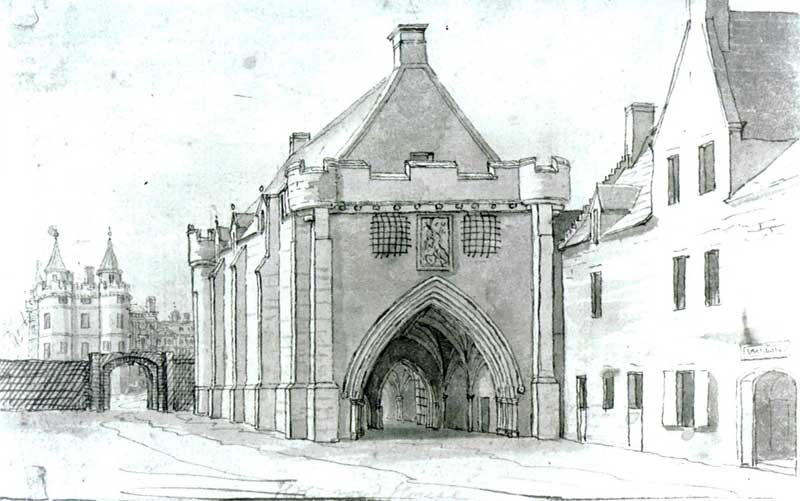
The work was carried out to a design by architect Sir William Bruce, the Surveyor-general of the Royal Works in Scotland, a position he held until 1678.
Interestingly Charles rejected Bruce’s first design.
Historic Environment Scotland (HES) reports that Bruce was paid a salary of £300 sterling.
“The newly rebuilt palace glorified Scotland and emphasised Edinburgh’s royal and government role.”
Royal Collection Trust
While Bruce, a pioneer of Palladian architecture in Scotland, may well be remembered for his work at Holyrood, his other commissions included the remodelling of Thirlestane Castle in the Scottish Borders for the Duke of Lauderdale.
His skill and imagination helped transform the building into the royal palace that we see today.
While Bruce, as architect managed the project, the work was carried out by Robert Mylne, the King’s Master Mason.
In 1683, with Bruce no longer in post, the king appointed another architect and master mason as Surveyor of the Royal Works.
He was James Smith who had already worked with Bruce and Mylne at Holyrood since 1671. He was paid £100 per annum less than Bruce.
However, by 1706 or possibly the following year, Smith was reporting the building’s state of repair in less than glowing terms. He said
“The palace of Holyroodhouse is in so dismal a condition both in the roof and windows that I am ashamed to write about it.”
James Smith
It seems that following the Act of Union in 1707, payment of his salary ceased and Smith had to travel to London to petition for the money he was owed.
Historic Environment Scotland references some work done by William Adam, one of Scotland’s most famous architects and his son John.
Further information about James Smith
The Newhailes Research Project has some interesting biographical notes on James Smith.
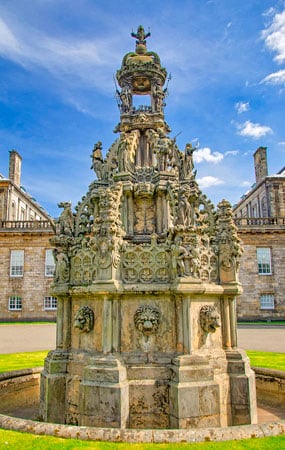
The notes include information about a number of projects he worked on including Holyrood Palace and Holyrood Abbey.
One of Smith’s less well-known projects was the building of the Canongate Kirk on Edinburgh’s Royal Mile.
Over the following years, other notable figures came to Edinburgh and visited Holyrood.
Bonnie Prince Charlie
Charles Edward Stuart (Bonnie Prince Charlie), stayed briefly in 1745, as did the Duke of Cumberland, the following year, after victory over Charles at the Battle of Culloden.
In 1822, George IV visited Edinburgh. It was the first visit by a reigning monarch to Scotland since Charles II was on the throne.
Organised by Sir Walter Scott, it was an extraordinary event, a ‘tartan extravaganza,’ was one of the politer descriptions.
By this time, the Palace had deteriorated and wasn’t really fit to host royal events.
However, the king did take part in the Ceremony of the Keys an event captured by David Wilkie, one of Scotland’s most celebrated artists.
Queen Victoria and Prince Albert
Queen Victoria and her husband Prince Albert were passionate about Scotland and made a considerable investment in the building and surrounding park.
Most notable perhaps was the new fountain modelled on the Renaissance fountain in the courtyard of Linlithgow Palace, the birthplace of Mary Queen of Scots.
It seems that Prince Albert was the driving force behind this.
George V continued the modernisation and the current royal family has plans for future development work.
SUGGESTIONS FOR FURTHER RESEARCH & READING
- Dunbar, J.G., 1963. The Palace of Holyroodhouse during the first half of the sixteenth century. Archaeological Journal, 120(1), pp.242-254.
- Jamieson, F., 1994. The Royal Gardens of the Palace of Holyroodhouse, 1500-1603. Garden History, 22(1), pp.18-36.
- Harrison, J., 1919. The History of the Monastery of the Holy-Rood and of the Palace of Holyrood House. W. Blackwood and Sons.
- Maxwell, H., 1908. Official Guide to the Abbey-church, Palace, and Environs of Holyroodhouse. W. Blackwood.
visitor information
Entry to the gardens, Holyrood Abbey and the Queen’s Gallery are included in the price of the ticket to Holyrood Palace.
For information on opening hours, cost of entry and other tips to help you plan your visit, go to the official Holyroodhouse website.